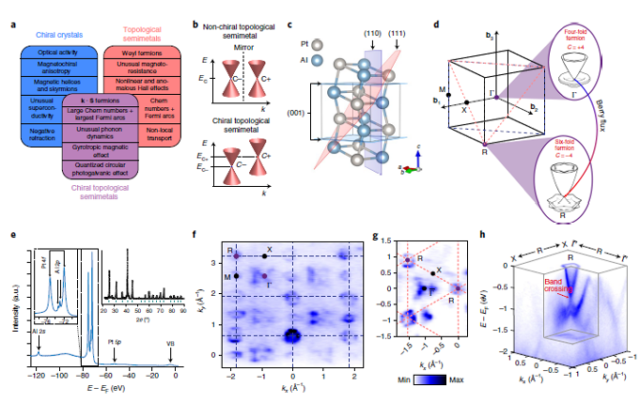A higher spin generalization of Weyl fermions without equivalence in elementary particle physics
Back in 1929, theoretical physicist Hermann Weyl predicted the existence of a new elementary particle with intriguing properties. Specifically, it would be massless (like a photon), have half-integer spin (like an electron) and exist in two mirror-image versions (like left- and right-handed gloves)—a property known as chirality.
Imagine there exist a material in which an electron could be split into two quasiparticles. These two quasiparticles both would carry electric charge, move in opposite directions but could not move backwards. Furthermore these quasiparticles would be massless. These are Weyl fermions.
This seems to be at odds with anything our common sense tells us. Because we know that the electron has a mass, but Weyl fermions have not; we know that the electron can move in any direction, but the quasiparticles break the time-reversal symmetry. Weyl fermions could exist in certain crystals known as “Weyl semimetals,” which can essentially split electrons inside into pairs of Weyl fermions that move in opposite directions. These Weyl fermions are not free-standing particles. Instead, they are quasiparticles that can only exist within those crystals. In other words, they are electronic activity that behaves as if they were particles in free space. Weyl fermions were detected experimentally in 2015 within in large crystals of tantalum arsenide (TaAs).
Weyl fermions and their properties make them very interesting objects from the practical point of view. To start with, Weyl fermions no mass implies they can move faster than electrons do, carrying charge with them, inside electronic systems. Furthermore, if they cannot move backwards they cannot bounce away from obstacles, meaning that they will have to zip through or around roadblocks; not like electrons, that can scatter backward when they collide, making their flow less efficient and generating heat.
In Weyl semimetals, Weyl fermions can also be described as point-like two-band crossings of the quasiparticle dispersion. These crossings are topologically protected because they carry a topological charge. This charge has an integer value (±1), which is known as the Chern number, and it is the one that gives the electronic wavefunction a handedness. In other words, in Weyl semimetals, not just the crystal structure itself, but also the electronic wavefunctions can exhibit a chirality.
Theoretically, although relativistic Weyl fermions must obey Lorentz symmetry, condensed matter systems are free from this constraint and instead need only be invariant under the space group of the crystal. This freedom gives rise to a much richer variety of topological semimetals, such as tilted Weyl semimetals and topological semimetals involving three, four or six band crossings protected by symmetry.
On the other hand, topological semimetals in crystals with a chiral structure are expected to display numerous exotic physical phenomena, but, till now, all experimentally confirmed topological semimetals exist in crystals that contain mirror operations, meaning that these properties do not appear.

Now, an international team of researchers that includes Ikerbasque Research Fellows Maia García Vergniory (DIPC) and Fernando de Juan (University of Oxford & DIPC), has found 1 that the crystal of AlPt is a structurally chiral topological semimetal that hosts new four-fold and six-fold fermions, which can be viewed as a higher spin generalization of Weyl fermions without equivalence in elementary particle physics.
AlPt crystallizes in the cubic chiral B20 structure of FeSi, which can be considered as a distorted rocksalt structure where the atomic positions are displaced along the (111) direction. The researchers conducted angle-resolved photoelectron spectroscopy (ARPES) measurements of AlPt crystals at low photon energies to investigate their surface electronic structures, as well as soft X-ray energies to study their bulk band structures. To understand the experimental results, they also performed ab initio band structure calculations.
As a result, they found that multifold fermions are located at high symmetry points and have Chern numbers larger than those in Weyl semimetals, thus resulting in multiple Fermi arcs that span the full diagonal of the surface Brillouin zone. By imaging these long Fermi arcs, they could determine experimentally the magnitude and sign of their Chern number, so that their dispersion and the handedness of their host crystal could be related.
In search for new physics, scientists are focused on building huge new colliders, but, as this work shows, new and exotic new particle physics can be found in humble little crystals.
Author: César Tomé López is a science writer and the editor of Mapping Ignorance
References
- Niels B. M. Schröter, Ding Pei, Maia G. Vergniory, Yan Sun, Kaustuv Manna, Fernando de Juan, Jonas. A. Krieger, Vicky Süss, Marcus Schmidt, Pavel Dudin, Barry Bradlyn, Timur K. Kim, Thorsten Schmitt, Cephise Cacho, Claudia Felser, Vladimir N. Strocov & Yulin Chen (2019) Chiral topological semimetal with multifold band crossings and long Fermi arcs Nature Physics doi: 10.1038/s41567-019-0511-y ↩
1 comment
[…] spin generalization of Weyl fermions without equivalence in elementary particle physics,” Mapping Ignorance, 09 May 2019. He de confesar que soy un gran admirador del trabajo en materiales topológicos de Maia G. […]